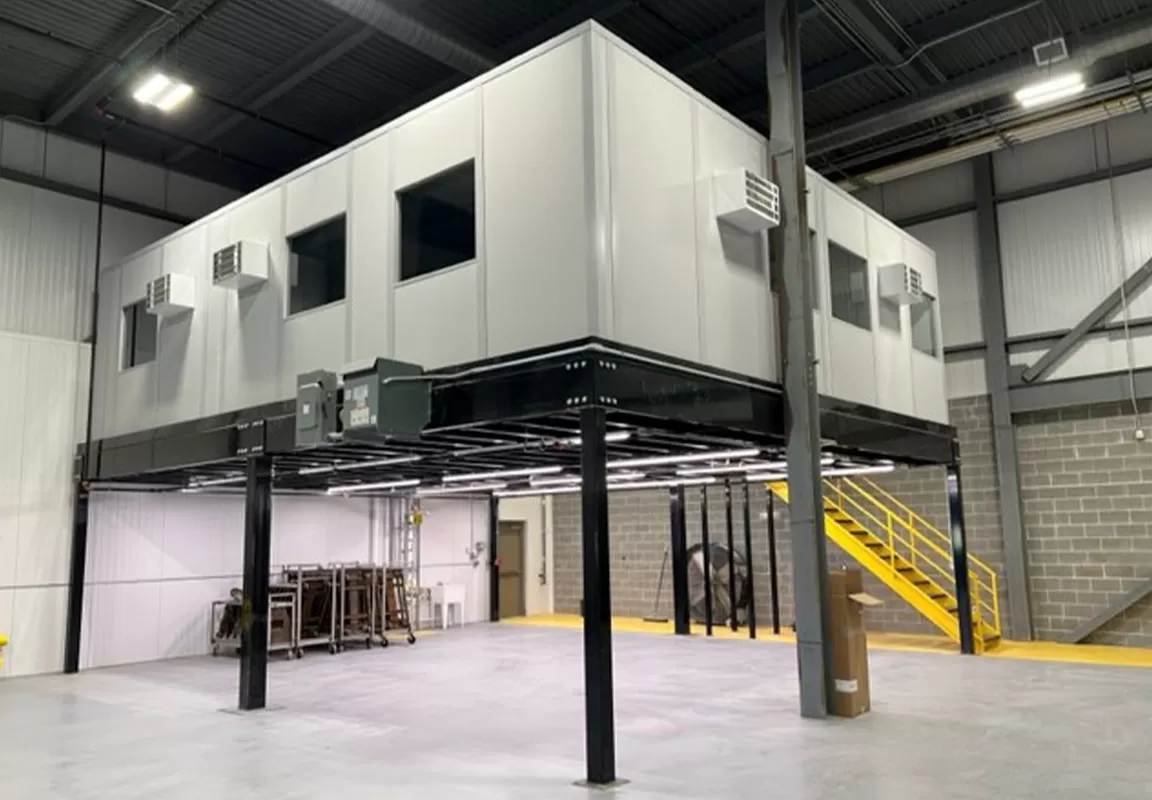Looking for a durable and safe office space that offers both fire-retardant and sound-deadening features? Look no further than modular and in-plant offices! are fully customizable office solutions that are constructed with high-quality materials that meet or exceed industry standards for fire safety and noise reduction. Contact our US warehouse solutions company to learn more.
Modular Office Types
- Two-Wall, Three-Wall, Four-Wall Options
- Demising Wall (Provides Area Separation)
- Cleanroom
- Two-Story Office
- Mezzanine Supported
- Sound Dampening/Dyno Room
Modular Office Applications

-
In-Plant Offices
Provide a safe and separate work environment for plant supervisors or for your employees on the factory floor.
-
Modular Break Rooms
Employees can utilize modular break rooms for conference meetings, coffee breaks, quick meetings, and just a safe space to relax.
-
CMM Rooms/Quality Labs
When you are required to have a temperature-controlled room for a Coordinate Measuring Machine (CMM), a modular office is the perfect solution to create that space. It will provide a clean environment, can control access to the machine and it will provide separation in a busy warehouse.
-
Conference Room Enclosures
We can design in-plant conference rooms that feel professional and provide the space you need to hold important group discussions.
-
Shipping & Receiving Offices
A modular shipping and receiving office in a busy warehouse isolates the operations from outside noise and distractions.
-
Sound & Dust Enclosures
Modular cleanrooms are required to meet specific government regulations and we can help design a solution that will keep sound, paint, and dust from going airborne.
-
Powder Coating & Paint Booths
Installing a modular powder coating booth can help protect your employees and can aid in the recapture of powder from overspray.
-
Guard Houses
Exterior, prefabricated, quick-ship weather shelter designed to serve as a security checkpoint or monitoring station at the entrance of a facility or property.
-
Lactation Suites
A mother’s room or lactation suite is a private space where a nursing mother can use a breast pump.
-
Control Rooms
Control rooms create a quiet, secure work environment for equipment operators. They offer a flexible and cost-effective solution for companies that require a quick and efficient way to expand or upgrade their control room capacity.
-
Computer Room
Temperature and humidity-controlled room to protect valuable computer equipment.
Industries That Use Modular Offices
- Manufacturing
- Distribution
- 3PL/Warehousing
- Medical
- Automotive Manufacturing
- Production
- Injection Molding
- Quality Lab
- Grow Room
Modular Office Features
- Modular Design
- Customization
- Durability
- Sound Absorption
- Modular Lighting
- Temperature Control
Modular Office Benefits

-
Cost Savings
Modular offices are typically less expensive than traditional construction methods, allowing businesses to save money on office construction.
-
Flexibility
Modular offices can be easily reconfigured or relocated, providing businesses with the flexibility to adapt to changing needs.
-
Improved Productivity
can help reduce distractions and noise within a workspace, improving employee productivity.
-
Increased Safety
Modular offices come standard with fire-rated walls, STC rating, and insulation properties providing a safer, quieter work environment.
-
Tax Benefits
Modular offices can be dismantled, relocated, and reassembled. Due to this, they are classified as tangible property with a seven-year depreciation life.
-
Space Utilization
Regain valuable floor space when placing a modular office on a mezzanine or work platform, or by creating a multi-story modular office.
-
Ease of Assembly
Modular offices go together like an erector set. They can be easily installed by in-house employees.
Pricing a Modular Office
Below is information that will help National Material Handling provide you with an accurate quote for your new project.
Building Usage
- Office, break room, laboratory, etc.
Building Drawing
- Width, depth, and height.
Attachment to Other Structures
- Will it be attached to an existing structure? If so, 1, 2, or 3 sides?
Other Requirements
- Number of doors, windows, outlets, etc.
Modular Office FAQ

-
Why Modular Office vs. Stick Built/Drywall Construction?
Modular warehouse offices offer more flexibility over traditional, stick-built constructions. They offer quicker installation time, they’re easily relocatable and there is little to no construction mess. Modular offices are a tax benefit because of their ability to be relocated. Assembly is so simple that it can typically be installed by plant personnel.
-
How Fast Can I Get a Modular Office?
Quick-ship options are available! Custom design is generally 4+ weeks.
-
Can Modular Offices Be Multiple Levels?
Yes, two- or three-level offices are available. Modular offices can also be placed on top of mezzanines or work platforms.
-
Can Modular Offices Be Cooled?
Yes, modular offices can come with through-wall HVAC units.
-
What Is the Typical Size of a Modular Office?
Panels are constructed 48” on center and 8’, 9’ and 10’ tall. A typical office is 12’x12’x10’. Taller offices can be achieved by stacking panels.
-
Can a Modular Office Be Subdivided?
Yes, modular offices can be subdivided, either at time of purchase or in the future with floor to underside of drop ceiling walls.
Modular Office Before & After
Request a Quote for Modular Offices & Cleanrooms
National Material Handling is proud to serve as your trusted US warehouse solutions company. Submit an RFQ today to learn more about our modular offices and cleanrooms. Call National Material Handling at (317) 886-0660 or fill out our online contact form to get started.



